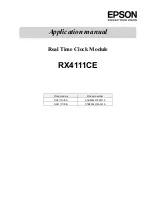
La Crosse Technology, Ltd. www.lacrossetechnology.com/support
Page 3
Explanation:
Many problems are resolved with fresh batteries of the appropriate voltage. Many items
sent in under warranty work when tested with fresh batteries. Batteries manufactured this year will have
an expiration date 10 years (or more) in the future. Battery technology has improved and batteries will
maintain voltage longer in storage. However, the environment the batteries reside in for the 10 years can
deplete the power.
Use Alkaline or Lithium batteries in the
outdoor sensors
.
A minimum voltage of 1.48V for each battery is necessary for proper performance.
Use batteries dated at least six years in advance of the current year. Batteries dated earlier than six
years from now may still work, but may be unstable in performance.
Good name brand batteries make less noise, which reduces the chance of RF (radio frequency)
interference from the battery compartment.
Power Requirements
2-AA
We recommend Alkaline batteries for the outdoor sensor.
You may choose to use Lithium batteries for temperatures below -20°F/-28.8°C.
Dashes show for Outdoor Temperature
Explanation:
Dashes mean the connection is lost between the projection alarm and the outdoor sensor.
can cause loss of connection between the outdoor sensor and the projection
alarm.
Turn the projection alarm 90 degrees towards the outdoor sensor to provide better reception. This
allows more antenna surface to face the outdoor sensor signal.
Try the
Inaccurate Outdoor Temperature Reading
Explanation:
High outdoor temperature readings are generally a location issue. Low outdoor temperature
readings are power related or a sensors going bad.
The outdoor sensor reads the environment where it is mounted. When mounted inside the home, it
will read inside temperature.
When the outdoor sensor reads high during the day, but not at night, it is a
positioning
problem.
Look for heat sources such as sunlight, door or window frames or reflected heat.
Side-by-side test:
Bring the outdoor sensor in the house and place it next to the projection alarm for 2
hours.
Compare indoor and outdoor temperature. The temperatures should be within 4 degrees to be within
tolerance.
If the outdoor sensor reads correctly when next to the projection alarm, try a different location outside.
Intermittent Outdoor Temperature
Explanation:
Intermittent problems are the hardest to resolve. RF (radio frequency) communication may
come and go occasionally. This can be normal in some environments (e.g. moister climates). If outdoor
sensor signal is lost, please wait 2-4 hours for the signal to reconnect on its own.
Move the outdoor sensor to a closer location.
can cause loss of outdoor sensor signal.
Freezer test:
Confirm the projection alarm is reading the correct outdoor sensor. Place the outdoor
sensor in the freezer for an hour and watch the temperature drop on the projection alarm.




























